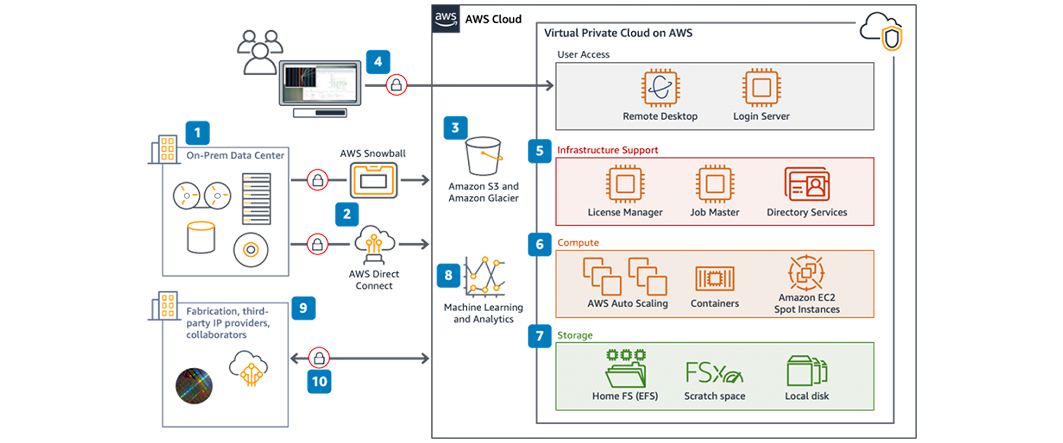EDA on AWS
EDA (Electronic Design Automation) on AWS
EDA (Electronic Design Automation) on AWS
EDA (Electronic Design Automation) on AWS refers to the use of Amazon Web Services (AWS) to run EDA workloads, such as circuit design and simulation, digital signal processing, and printed circuit board design.
As integrated circuits progress to higher integration and newer technology nodes, the IC design process becomes substantially more difficult. Design companies are losing time and money as the computing needs for effective EDA tools for design, analysis, and simulation increase significantly.
Typical requirements for electronic design automation (EDA) workloads include a computing cluster, a process scheduler to manage the allocation of jobs to compute nodes, and a high-performance shared file system. Depending on the EDA workload use case, design size, and total number of cores, the shared file system’s throughput needs might be anywhere from 500 MB/sec to 10 GB/sec. License management, remote desktops and visualizations, user administration including identification and access restrictions, budgeting, and monitoring, and so on are all crucial parts of the EDA infrastructure stack.
AWS provides a range of services and tools that can be used to support EDA workloads, including:
-
- Compute services: AWS offers a variety of computing services, such as EC2 (Elastic Compute Cloud) and Fargate, that can be used to run EDA workloads and perform simulations and other compute-intensive tasks.
-
- Storage services: AWS offers a range of storage services, such as S3 (Simple Storage Service), that can be used to store and manage large amounts of EDA data, including design files and simulation results. For high-performance storage options, you can choose from:
-
- Block storage (Local NVMe, SSD, Amazon EBS)
-
- File storage (Amazon EFS, FSx for Lustre)
-
- Object storage (Amazon S3, Amazon S3 Glacier)
-
- Networking services: AWS provides networking services, such as VPC (Virtual Private Cloud) and Direct Connect, that can be used to securely connect EDA workloads to the network and other resources.
- Storage services: AWS offers a range of storage services, such as S3 (Simple Storage Service), that can be used to store and manage large amounts of EDA data, including design files and simulation results. For high-performance storage options, you can choose from:
-
- Artificial Intelligence and Machine Learning services: AWS provides a variety of AI and ML services, such as SageMaker, that can be used to run and scale EDA workloads that involve machine learning or deep learning.
-
- DevOps services: AWS provides DevOps services, such as CodeCommit and CodeBuild, that can be used to automate the build and deployment of EDA applications and workloads.
Following is a reference architecture diagram detailing the EDA stack on AWS.
AWS also offers a range of tools and services that can be used to optimize and manage EDA workloads on AWS, such as AWS Batch and AWS Auto Scaling, to ensure that resources are used efficiently and cost-effectively.
Note: These are some of the common services and tools used for EDA on AWS, and the specific services and tools you use may vary based on the size and complexity of your EDA workloads, as well as your specific requirements and constraints.
Conclusion
Over the past decade, cloud-based collaborative EDA design has changed gradually and dramatically. Running EDA on AWS offers a range of benefits, including scalability, cost savings, flexibility, and security. With a wide range of services and tools available, AWS makes it easy


